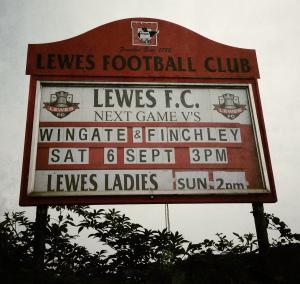Monday 1st September 2014. Transfer deadline day. Whilst Sky Sports have sent reporters to the four corners of the English footballing universe for a sighting of a player/manager/agent/tea lady arriving in a car with blacked out windows, I am sitting outside a deserted Dripping Pan at Lewes FC. With the squad currently decimated by injuries and suspensions I am sure that any minute someone of interest will turn up.

This theory can be applied perfectly to the madness that occurs on that final day of the transfer window, when panic and desperation replace common sense. Normally prudent football clubs act like kids in a sweet shop, grabbing any players they can as the time ticks down just so they can say to their fans that they have taken part. The expectations of fans today is that the club has to strengthen at all costs, in many cases just to keep up with Jones United. What other reason can there be for the ever increasing sums of money spent by 20 Premier League clubs?
This summer all records were broken. As clubs counted the cost of their acquisitions and players’ agents booked their holidays on their own private islands, many observers simply scratched their heads. The cost? Over £900 million.
When you look at some of the transfers, it is difficult to see how many clubs will ever get a return on their investments. As a knee-jerk reaction to the season from hell, and the indifferent start to the season, the biggest spenders were Manchester United, who paid over £153 million on players such as Di Maria (just £59 million), Danny Blind and Falcao. Whilst Manchester United have been the most successful English club of the past two decades, their record in paying big money for players has been appalling. Nani (£17 million), Anderson (£20 million), Fellaini (£27 million) and Veron (£28 million) have been the headline makers for the wrong reason, but also don’t forget Bebe, signed for over £7 million, who played twice for United. Whether the £37 million they paid for Juan Mata last season will ever be justified is another story. Incredibly expensive mistakes.
Liverpool decided to just buy the whole Southampton team this summer, spending over £115 million in total, although they did get a significant sum from Barcelona for Luis Suarez. West Ham’s outlay of £35 million included £12 million for Enner Valencia, a massively overpriced player and testament to the effect of a couple of goals in the World Cup. Mark my words, he will be loaned out to a team in Spain within a year, citing homesickness as a reason why he hadn’t scored any goals.
Clubs simply do not learn their lessons. West Ham have an appalling record of making panic buys in the transfer windows. Faced with massive valuations on English players (Andy Carroll at £15 million, for instance) they are forced to spread their net far and wide. Out of the 20 Premier League clubs, only two made English players their biggest signings (Adam Lallana from Southampton to Liverpool and Jack Rodwell from Manchester City to Sunderland). Ten of these big signings had played in the 2014 FIFA World Cup, with players such as Sanchez (Arsenal – £35 million) and Di Maria (Manchester United – £59 million) increasing their values with a couple of decent 90-minute run outs.
Interestingly, the club that spent the least amount of money this summer was Stoke City, who paid £3m for Spanish midfielder Bojan Krkic in their only real investment. In the past few years they had actually been one of the biggest spenders, not only in England, but across Europe, laying out over £63 million during the past five years. That pales into insignificance compared to Premier League new boys Queens Park Rangers, who took their spending in the same period to over £106 million with their signing of Sandro from Spurs for £10 million. ‘Appy ‘Arry also brought in Nico Kranjcar for the third time in his career. The Croatian must have something on ‘Arry – that is the only explanation for such an average player being given expensive chance after chance.
So back to a wet and windy Dripping Pan. Just like all other non-league clubs, the transfer window is irrelevant. Thanks to the quirks of the transfer system in the lower leagues we can bring in players at any time, right up until the final few weeks of the season. There wouldn’t be any late arrivals tonight, nor would there be any dramatic midnight press conferences. Would anyone new be joining the Rooks? Quite possibly, but for now Messrs. Wilson and Bloor were playing their cards very close to their chest.
About these ads

